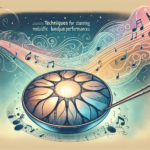Introduction
The art of relaxation is as essential to our well-being as physical exercise and a balanced diet. In today’s fast-paced world, the search for effective methods to release stress and achieve a tranquil state of mind is more important than ever. One such method that has gained popularity in recent years is the use of handpan sounds to enhance relaxation. The unique and captivating melodies produced by the handpan can create an immersive auditory experience that promotes mindfulness and relaxation.
The Handpan: An Overview
The handpan is a relatively new musical instrument, invented in the early 21st century. It is a member of the idiophone family, which means it produces sound primarily by the vibration of its material, without the need for strings or a membrane. The handpan is typically crafted from two hemispherical shells of nitrogen-treated steel, which are fastened together to create a resonant body. Each instrument features a central note called the ‘ding’ and a series of tone fields arranged in a circular pattern around it.
Handpan Sounds and Brain Waves
One of the reasons handpan sounds are so effective in promoting relaxation is their impact on brain waves. The human brain operates on different frequencies, which can be measured using electroencephalography (EEG). These frequencies are categorized into four primary types: beta, alpha, theta, and delta.
- Beta Waves (14-30 Hz): These are associated with active thinking, problem-solving, and a heightened state of alertness.
- Alpha Waves (8-13 Hz): These are linked to a state of relaxed wakefulness, often experienced during meditative practices.
- Theta Waves (4-7 Hz): These waves are present during light sleep and deep relaxation, often accompanied by vivid imagery and a sense of being in a dream-like state.
- Delta Waves (0.5-3 Hz): These are associated with deep sleep and the most profound states of relaxation.
Handpan music generally features slow tempos, gentle melodies, and harmonic overtones that encourage the brain to transition from beta waves to alpha and theta waves. This shift can facilitate a meditative state, reduce anxiety, and promote a deep sense of calm and well-being.
Handpan Sounds and Breath Control
Mindful breathing is a cornerstone of many relaxation techniques, such as yoga, tai chi, and meditation. The rhythmic patterns and soothing tones of handpan music can serve as an anchor for breath control exercises, helping individuals to synchronize their breathing with the melodies. This synchronization can foster a focused and meditative state, allowing for deeper relaxation and mental clarity.
Research has shown that synchronized breathing and music can enhance the autonomic nervous response, reducing heart rate variability and promoting a state of calm. By incorporating handpan sounds into a regular mindfulness practice, individuals can achieve a deeper connection between mind and body, leading to enhanced relaxation and stress reduction.
Cognitive Benefits of Handpan Music
Beyond relaxation, handpan music can also offer various cognitive benefits. Listening to music engages multiple areas of the brain, including those responsible for attention, memory, and emotional processing. Handpan music, with its intricate yet repetitive patterns, can stimulate these brain regions and facilitate cognitive functions such as:
- Enhanced Focus: The complex yet calming nature of handpan music can help improve concentration and attention span, making it an ideal background soundtrack for tasks requiring sustained focus.
- Memory Improvement: Regular exposure to music, including handpan sounds, can enhance verbal memory and learning abilities, potentially benefiting those engaged in cognitive training or educational activities.
- Emotional Regulation: The soothing qualities of handpan music can aid in emotional regulation, helping individuals to navigate stress, anxiety, and emotional turbulence more effectively.
Handpan Sounds in Therapeutic Practices
Given its profound impact on relaxation and cognitive function, it is no surprise that handpan music has found its place in various therapeutic practices. Music therapy, a clinical and evidence-based practice, leverages the therapeutic properties of music to address physical, emotional, cognitive, and social needs. The unique attributes of handpan sounds make them particularly well-suited for this purpose.
Handpan music has been integrated into a variety of therapeutic settings, including:
- Stress Reduction Programs: By facilitating relaxation and reducing anxiety, handpan music can be a valuable component of stress reduction programs aimed at improving overall mental health.
- Meditation and Mindfulness Practices: The calming and hypnotic qualities of handpan music make it an excellent accompaniment to meditation and mindfulness routines, enhancing the overall experience and deepening the sense of tranquility.
- Rehabilitation and Pain Management: Music therapy, including the use of handpan sounds, has been shown to alleviate pain perception and improve the recovery process in individuals undergoing physical rehabilitation.
Incorporating Handpan Music into Daily Life
The beauty of handpan music lies not only in its hypnotic melodies but also in its versatility. There are numerous ways to incorporate handpan sounds into daily life to enhance relaxation and overall well-being.
- Morning Routine: Starting the day with a few minutes of handpan music can set a positive tone and create a sense of calm that carries through the day.
- Work Breaks: Taking short breaks to listen to handpan music can help reduce stress and improve focus, leading to increased productivity and mental clarity.
- Evening Wind-Down: Incorporating handpan music into an evening wind-down routine can aid in the transition from the busyness of the day to a state of relaxation, promoting better sleep quality.
- Meditation Sessions: Using handpan sounds as a backdrop for meditation can enhance the practice, deepening the meditative state and facilitating a sense of inner peace.
- Creative Endeavors: Handpan music can serve as an inspirational and calming background for creative activities such as writing, painting, or crafting.
Conclusion
The mesmerizing melodies of the handpan have a unique ability to resonate with our natural rhythms, fostering a state of mindfulness and relaxation. Whether used for personal leisure, cognitive enhancement, or therapeutic purposes, the handpan’s sounds have a profound impact on mental well-being. By understanding the connection between handpan music and brain wave activity, breath control, and cognitive functions, individuals can harness the power of this exceptional instrument to promote relaxation, enhance focus, and improve overall quality of life.
Integrating handpan music into daily routines and therapeutic practices presents a valuable opportunity to explore new avenues of relaxation and mental clarity. As awareness of its benefits continues to grow, so too does the potential for the handpan to become a staple in the pursuit of holistic well-being.
FAQs
1. What exactly is a handpan?
A handpan is a musical instrument made of two hemispherical shells of steel, connected to form a resonant body. It produces melodic and harmonic tones when tapped or struck, and each instrument features a central note called the ‘ding’ surrounded by a series of tone fields.
2. How does handpan music affect brain waves?
Handpan music can promote relaxation by encouraging the brain to shift from beta waves (associated with active thinking) to alpha and theta waves (linked to relaxed wakefulness and deep relaxation). This transition facilitates a meditative state, reduces anxiety, and promotes a sense of calm.
3. Can handpan music be used in therapeutic settings?
Yes, handpan music has been successfully integrated into various therapeutic practices, including stress reduction programs, meditation and mindfulness routines, and rehabilitation and pain management. Its calming and hypnotic qualities make it a valuable tool for enhancing overall mental health and well-being.
4. How can I incorporate handpan music into my daily routine?
There are several ways to incorporate handpan music into daily life, such as starting the day with a few minutes of listening, using it during work breaks to reduce stress, incorporating it into evening wind-down routines, using it as a backdrop for meditation, and playing it during creative activities.
5. What are some cognitive benefits of listening to handpan music?
Handpan music can enhance focus, improve memory, and aid in emotional regulation. Its intricate yet repetitive patterns stimulate brain regions responsible for attention, memory, and emotional processing, making it an effective tool for cognitive enhancement and stress reduction.





